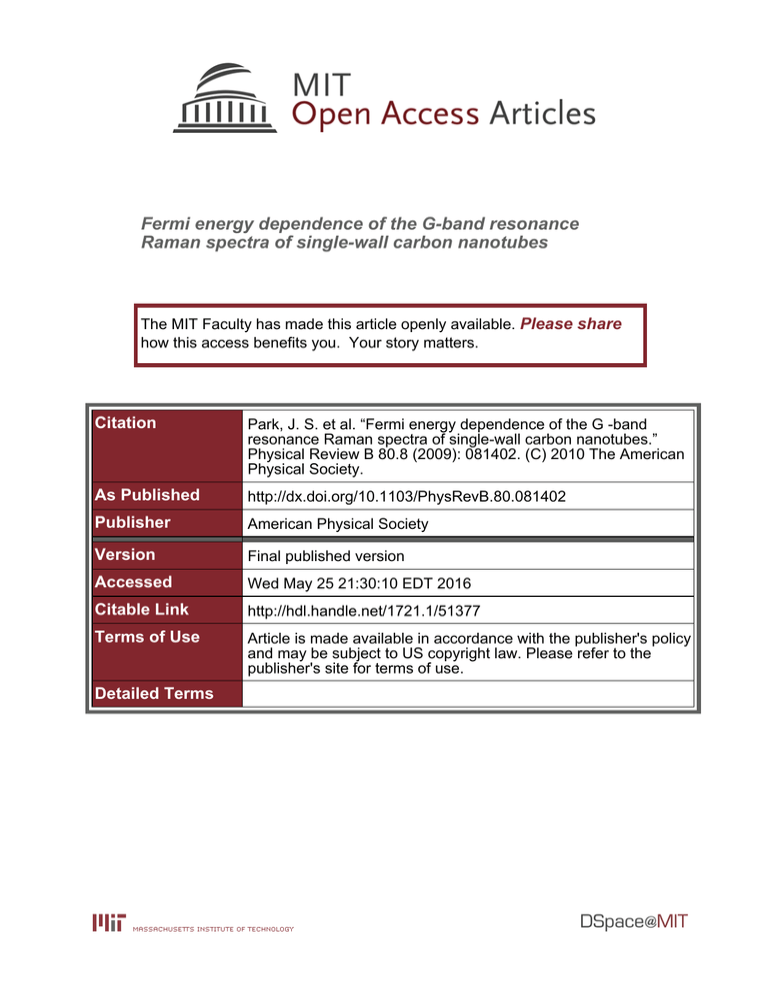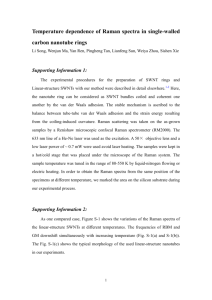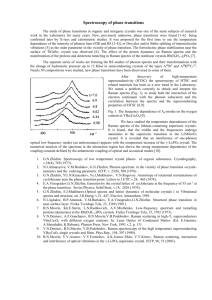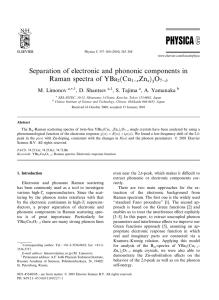Fermi energy dependence of the G-band resonance Please share
advertisement

Fermi energy dependence of the G-band resonance Raman spectra of single-wall carbon nanotubes The MIT Faculty has made this article openly available. Please share how this access benefits you. Your story matters. Citation Park, J. S. et al. “Fermi energy dependence of the G -band resonance Raman spectra of single-wall carbon nanotubes.” Physical Review B 80.8 (2009): 081402. (C) 2010 The American Physical Society. As Published http://dx.doi.org/10.1103/PhysRevB.80.081402 Publisher American Physical Society Version Final published version Accessed Wed May 25 21:30:10 EDT 2016 Citable Link http://hdl.handle.net/1721.1/51377 Terms of Use Article is made available in accordance with the publisher's policy and may be subject to US copyright law. Please refer to the publisher's site for terms of use. Detailed Terms RAPID COMMUNICATIONS PHYSICAL REVIEW B 80, 081402共R兲 共2009兲 Fermi energy dependence of the G-band resonance Raman spectra of single-wall carbon nanotubes J. S. Park,1 K. Sasaki,2 R. Saito,1 W. Izumida,1 M. Kalbac,3 H. Farhat,4 G. Dresselhaus,5 and M. S. Dresselhaus6,7 1Department of Physics, Tohoku University and CREST, Sendai 980-8578, Japan Institute for Material Science, Tsukuba 305-0044, Japan 3J. Heyrovsky Institute of Physical Chemistry, Academy of Sciences of the Czech Republic, CZ-18223 Prague 8, Czech Republic 4Department of Materials Science and Engineering, Massachusetts Institute of Technology, Cambridge, Massachusetts 02139-4307, USA 5 Francis Bitter Magnet Laboratory, Massachusetts Institute of Technology, Cambridge, Massachusetts 02139-4307, USA 6 Department of Electrical Engineering and Computer Science, Massachusetts Institute of Technology, Cambridge, Massachusetts 02139-4307, USA 7Department of Physics, Massachusetts Institute of Technology, Cambridge, Massachusetts 02139-4307, USA 共Received 29 May 2009; published 4 August 2009兲 2National The Fermi energy dependence of the G-band resonance Raman spectra of single-wall carbon nanotubes 共SWNTs兲 is calculated, including the Kohn anomaly effect for metallic tubes. The gate voltage dependence of the G-band Raman spectra for SWNTs shows chirality-dependent G+ / G− spectra, reflecting their dependence on the eigenvector direction of the optical 共LO and TO兲 phonon modes and the nanotube chirality. DOI: 10.1103/PhysRevB.80.081402 PACS number共s兲: 78.67.⫺n, 73.63.Fg The G-band Raman spectra of single-wall carbon nanotubes 共SWNTs兲 arise from the first-order, one-phonon, and intravalley G-band Raman-scattering processes,1,2 which have been widely utilized for characterizing SWNTs and graphene. The G-band spectra of a SWNT consist of a higher-frequency peak 共G+兲 near 1580⬃ 1590 cm−1 and a lower-frequency peak 共G−兲 in the range 1550⬃ 1570 cm−1. For semiconducting tubes 共S-SWNT兲, the G+ and G− peaks can be assigned to longitudinal-optical 共LO兲 and transverseoptical 共TO兲 phonon modes, respectively, while the G+ and G− peaks of metallic tubes 共M-SWNTs兲 are assigned to TO and LO phonon modes, respectively, because of the Kohn anomaly 共KA兲 effect for phonons at the ⌫ point.3–8 For the KA effect, the self-energy correction to the LO and TO phonon modes by the virtual excitation of an electron-hole pair causes a softening and a hardening of the LO and TO phonon frequencies, respectively.7–9 Recently Nguyen et al.7 and Farhat et al.8 observed the Fermi energy 共EF兲 dependence of the phonon-softening effect of SWNTs by using an electrochemical gate, and their results clearly show that the LO phonon mode softens as a function of EF. Thus the EF-dependent Raman spectra measurement is important for SWNT field effect transistor operation. However, the observed G-band Raman spectra of an individual SWNT show an anomalous behavior depending on the chirality 共n , m兲 of a SWNT,10 caused in part by the dependence of the relative intensity of the Raman G+ to G−-band features 共IG+ / IG−兲 on the chirality and diameter.11 For S-SWNTs, the G+ peak is dominant at the zigzag chiral angle 共 = 0°兲, while both the G+ and G− peaks appear at other chiral angles 共0 ° ⬍ ⬍ 30°兲. It has been known that the k-dependent electron-phonon 共el-ph兲 interaction gives rise to the chirality dependence of both the G-band 共Refs. 9 and 12兲 and radial breathing mode 共RBM兲 共Ref. 12兲 Raman intensities. Thus the G-band spectral analysis is still not well understood, even though the G band has been studied for many years. In this Rapid Communication, resonance Raman spectra of SWNTs as a function of EF are calculated in order to 1098-0121/2009/80共8兲/081402共4兲 understand and interpret the chirality and EF-dependent G-band spectra. We show here that the k-dependent el-ph interaction affects both the IG+ / IG− relative Raman intensity and their spectral widths. The self-energy corrections to the G-band phonon frequencies due to the KA affect not only the LO mode but also the TO mode, and both the LO and TO phonon frequencies depend on the chiral angle . The G-band Raman intensity I is calculated as a function of phonon energy ប and laser excitation energy EL by1,13 I共,EL兲 = 兺 j 冏兺 a,b Mop共j,b兲Mep共b,a兲Mop共a, j兲 ⌬Eaj共⌬Ebj − ប兲 冏 2 共1兲 in which ⌬Eaj ⬅ EL − 共Ea − E j兲 − i␥, while j, a, and b, respectively, denote an initial state in the valence band, an excited state in the conduction band, and a scattered state for an excited electron. The electron-photon matrix elements 共Mop兲 共Refs. 14 and 15兲 and the el-ph matrix elements 共Mep兲 共Ref. 12兲 are calculated by the extended tight-binding 共ETB兲 model.16,17 Here ␥ is defined by an energy full width half maximum 共FWHM兲 of the Raman excitation profile, also called the resonance window.18 ␥ is calculated by the uncertainty relation between ␥ and the lifetime of a photoexcited carrier, which depends on the SWNT diameter dt and by experiment.18 The dominant lifetime of a photoexcited electron in the conduction band is determined by fast phonon emission processes for all phonons that have nonzero matrix elements Mep and ␥ is given by the Fermi golden rule.18 Thus ␥ is written as ␥ = 2 兺 兺 兩具f兩Hep兩a典兩2␦共E f − Ea ⫾ ប兲, 共2兲 f where each term in the summation taken over the final state 具f兩 indicates the transition probability per unit of time from an initial photoexcited state 兩a典 to 具f兩. The delta function ␦共E f − Ea ⫾ ប兲 expresses the energy-momentum conservation in the phonon emission and absorption processes, and 081402-1 ©2009 The American Physical Society RAPID COMMUNICATIONS PHYSICAL REVIEW B 80, 081402共R兲 共2009兲 PARK et al. G 5 + (11,6) (12,4) (13,2) 1400 G 1500 + 1600 -1 Raman shift (cm ) 共3兲 (b) 4 3 LO (14,0) (13,2) (12,4) 1 0 40 (11,6) (10,8) 2n+m=22 2 (12,4) (13,2) (14,0) (14,0) (c) (13,2) (12,4) 30 0 (d) 10 (11,6) 2n+m=28 (10,8) TO 10 (11,6) θ (10,8) 20 30 (e) 2n+m=27 33 5 30 0 0 (f) φTO 10 θ 20 30 φLO 90 (g) φTO in which the factor 2 comes from spin degeneracy and Ee共k兲关Eh共k兲兴 is an electron 共hole兲 energy with wave vector k, and 具eh共k兲兩Hep兩共0兲典 represents the el-ph matrix element for creating an electron-hole pair with k by the el-ph interaction Hep, and f共E兲 is the Fermi distribution function. The G-band spectral width is given by the decay width ⌫. We calculate ⌫ self-consistently by calculating ⌫ = −Im共ប共2兲兲.9 It is noted that ␥ and ⌫ are different from each other, though the interactions of ␥ and ⌫ originate from the same Hep. ␥ originates from the lifetime of a photoexcited carrier, while ⌫ originates from the lifetime of the phonon. In the experiment, ␥ and ⌫ appear, respectively, in the Raman excitation profile and in the Raman spectrum. Figure 1共a兲 shows the calculated resonance Raman spectra for the G band of type I S-SWNTs 共Ref. 9兲 with family number p = 2n + m = 28. The 共n , m兲 SWNTs with the same family number p have a similar diameter to one another. The S for each 共n , m兲 EL and ␥ 关see Fig. 1共c兲兴 are taken from E22 SWNT. The chiral angle can vary from = 0° to ⬃ 30°. The intensity of the G− peak 共TO兲 is always smaller than that of R,LO R,TO ⬎ Mep , as shown in Fig. the G+ peak 共LO兲 because Mep 1共b兲, in which the notation R indicates the Raman scattering. It is important to point out that the electron-phonon matrix elements for Raman and KA are different9 since both initial and final states are different. In particular, the intensity of the R,TO for zigzag G− peak vanishes for a 共14,0兲 SWNT since Mep R is calcuSWNTs is zero, as shown in Fig. 1共b兲. Here Mep lated for the phonon amplitude at 300 K. These calculated G-band Raman spectra can be compared with previous experimental results, which show only one peak in the G-band spectra of 共n , m兲 SWNTs with special chiral angles.10 The observed 共n , m兲 SWNT can be assigned as a zigzag SWNT by the calculation. In order to explain this, the el-ph matrix elements for the LO and TO phonons with q = 0 are given by9 80 (h) 10 0 0 10 θ 20 共4兲 respectively, where g is the el-ph coupling constant, u is the phonon amplitude, and ⌰R共k兲 is defined by an angle between the k vector from the K point of the 2D Brillouin zone to the van Hove singular point, kii, and the circumferential direction vector, K1,19 as shown in Fig. 1共e兲. Since ⌰R共k兲 is zero for R,TO R,LO = 0, while Mep has a all zigzag SWNTs 共k 储 K1兲, Mep 9 maximum value. The ⌰R vs for SWNTs with the same 30 FIG. 1. 共Color online兲 共a兲 The G-band spectra for S-SWNTs with the same family number p = 2n + m = 28. 共b兲 el-ph matrix elements MRep vs chiral angle for the LO and TO phonons and for two different family numbers 共22 and 28兲. 共c兲 ␥ vs for members of family p = 28. 共d兲 Plot of ⌰R vs for three 2n + m families of M-SWNTs. 共e兲 The angle ⌰R to the cutting line for the polar coordinate of a k vector at the van Hove singular point. 共f兲 The angle between the tube axis and the phonon eigenvector direction for a 共12,6兲 SWNT. The calculated angles vs for 共g兲 TO and 共h兲 LO phonons fitted by the function given in the text. family number p is shown in Fig. 1共d兲. For the TO phonon R mode, the Mep for the SWNT with a similar increases with decreasing dt because of the diameter dependence in the circumferential direction12 as shown in Fig. 1共b兲. In a previous paper,9 we pointed out the importance of the angle between the SWNT axis and the phonon eigenvector for the LO and TO phonons for the el-ph matrix elements.20 In fact, when we consider , then Eq. 共4兲 is modified by 具e共k兲, LO兩Hep兩e共k兲典 = gu cos关⌰R共k兲 + 兴, 具e共k兲, TO兩Hep兩e共k兲典 = − gu sin关⌰R共k兲 + 兴. R,LO ⬅ 具e共k兲, LO兩Hep兩e共k兲典 = gu cos ⌰R共k兲, Mep R,TO ⬅ 具e共k兲, TO兩Hep兩e共k兲典 = − gu sin ⌰R共k兲, Mep - (14,0) ប共0兲 − 关Ee共k兲 − Eh共k兲兴 + i⌫ ⫻兵f关Ee共k兲 − EF兴 − f关Eh共k兲 − EF兴其 G Mel-ph (meV) Intensity (arb. unit) 兩具eh共k兲兩Hep兩 典兩 (10,8) φLO k 共0兲 2 ΘR ប共2兲 = 2 兺 (a) γ (meV) 具f兩Hep兩a典 indicates the el-ph interaction matrix element for 24 possible phonon-scattering processes.12 The phonon frequency of the LO and TO phonon modes at the ⌫ point for M-SWNTs is calculated by including the KA effect. The phonon energy ប becomes ប = ប共0兲 + ប共2兲, where 共0兲 is the original phonon frequency without the el-ph interaction, and 共2兲 is the quantum correction to 共0兲, which is given by9 共5兲 Figures 1共f兲 and 1共g兲 show that the calculated angle changes smoothly as function of . The sum LO + TO for a general chiral angle always becomes / 2 because of symmetry. The angle vs for the LO and TO phonons can be fitted by the chiral angle dependence 共A + B + C2兲sin共6兲, where A, B, and C are fitting parameters and is the chiral angle in units of degrees 共 ° 兲. For LO, A = 26.9, B = −76.3, and C = 84.5. For TO, A = −26.7, B = 75.4, and C = −83.2. This dependence should be taken into account when carrying out Raman spectral calculations. 081402-2 RAPID COMMUNICATIONS PHYSICAL REVIEW B 80, 081402共R兲 共2009兲 FERMI ENERGY DEPENDENCE OF THE G-BAND… G 4 + (11,8) (12,6) (13,4) 3 2n+m=30 2n+m=24 2 (13,4) (12,6) 1 (14,2) (14,2) G - (15,0) 1400 1500 1600 (10,10) (b) LO Mel-ph (meV) (10,10) - -1 Raman shift (cm ) 0 30 (11,8) TO (10,10) (15,0) (14,2) (13,4) (15,0) (12,6) 25 10 θ 20 (11,8) (b) (15,0) (c) EF +0.2eV +0.1eV 0eV -0.1eV (c) -0.2eV (11,8) 1500 1600 (10,10) 0 (a) Intensity (arb. unit) G γ (meV) Intensity (arb. unit) (a) 1500 1600 1500 1600 −1 Raman shift (cm ) 30 FIG. 2. 共a兲 The G-band spectra of M-SWNTs with the same family number p = 30 and EF = 0. 共b兲 el-ph matrix elements vs for the LO and TO phonons and for two different family numbers. Open circles indicate the Mep values for the family number p = 30. 共c兲 ␥ vs for members of p = 30. Figure 2共a兲 shows the calculated Raman spectra for the G band of M-SWNTs with family number p = 30 and EF = 0. M for each The EL and ␥ 关see Fig. 2共c兲兴 are taken from E11 − 共n , m兲 SWNT. The G peak intensity is larger than that of the G+ peak because the G−共G+兲 peak corresponds to the LO 共TO兲 phonon due to the LO phonon softening in which R,LO R,TO ⬎ Mep for any value, as shown in Fig. 2共b兲. The Mep relative intensities of the two peaks, G+ and G−, are affected by the Raman spectral width, which relates to the phonon lifetime, ⌫. For the 共10,10兲 armchair SWNT, the G+共TO兲 peak width is significantly smaller than those of the G−共LO兲 peak and of the G+ peaks for the other chiral tubes. Therefore, the G+ peak intensity of the 共10,10兲 tube becomes large compared with the other chiral SWNTs, even though the R,TO for the armchair tube has a smaller value than for the Mep other chiral tubes. It is noted that the Raman peak intensity is R and small ⌫ values, which is determined by the large Mep + − the reason why the G / G spectra show an irregular behavior as a function of 共n , m兲. For the 共15,0兲 zigzag SWNT, only R,TO vanishes for zigzag the G+ peak appears because Mep nanotubes as seen in Eq. 共4兲. The other chiral tubes in this family, 共11,8兲, 共12,6兲, 共13,4兲, and 共14,2兲, show various intermediate intensity ratios. In Fig. 2共c兲, we show that ␥ decreases monotonically with increasing . Because of the small difference of the ␥ and of the el-ph coupling for the LO phonon as compared to that of the TO for a change in , the G− peak intensity does not show a large change for the different chiral SWNTs. The G+ / G− spectral feature depends on but is more sensitive to the EF position, especially for M-SWNTs. Figure 3共a兲 shows the calculated G-band spectra for various EF at 300 K for a 共10,10兲 armchair SWNT. Here we did not consider the changes in the C-C bond or the Eii transition energy by doping with electron or holes. In the experiment, the Eii is slightly changed with changing EF, which results in an off-resonance situation for a fixed laser excitation energy EL. Here, +EF 共−EF兲 corresponds to electron 共hole兲 doping. When EF is changed from EF = 0, the G− peak shows a frequency shift and a sharpening of the spectral width, while the G+ peak does not give any change in frequency or width. Sasaki et al.9 reported that an intermediate electron-hole pair FIG. 3. The G-band spectra for three M-SWNTs with different chiral angles taken by changing the Fermi energy from EF = −0.2 to 0.2 eV. 共a兲 共10,10兲. 共b兲 共11,8兲. 共c兲 共15,0兲. state contributes to the softening of the LO phonon but does not couple to the TO phonon for armchair SWNTs. For the chiral M-SWNT 共11,8兲 as shown in Fig. 3共b兲, both the LO and TO phonons couple to the intermediate electron-hole pair state, which is excited by a lower-energy phonon. The TO phonon becomes harder for EF = 0 eV since the intermediate state of an electron-hole pair for E ⬍ បTO contributes to a TO phonon hardening.9 In the case of the 共15,0兲 SWNT, R,TO , the G+ peak always vanishes because of a vanishing Mep as discussed above. KA for the KA effect in Eq. 共3兲 is The matrix element Mep 9 given by KA,LO Mep ⬅ 具eh共k兲兩Hep兩LO典 = igu sin ⌰KA共k兲, KA,TO Mep ⬅ 具eh共k兲兩Hep兩TO典 = − igu cos ⌰KA共k兲, 共6兲 where ⌰KA共k兲 is defined by the angle between the k point taken on a cutting line for two-linear metallic subbands and the nanotube circumferential direction of a unit vector, K1. For the armchair nanotube, the cutting line for the two-linear metallic bands lies on the nanotube axis direction unit vector, and then ⌰KA is / 2 共− / 2兲, which gives a vanishing KA,TO . For a chiral nanotube, ⌰KA is not zero since the Mep cutting line for the two-linear metallic bands deviates from the K point due to the curvature effect, and then the KA effect appears in both the LO and TO modes. For the zigzag M-SWNT 共15,0兲, only the G+ peak related to the TO phonon appears since the el-ph matrix element for the Ramanscattering process has a zero value, as shown in Fig. 2共b兲. Thus, we only measure a LO phonon softening experimentally, even though a TO phonon hardening was expected theoretically. The calculated G-band Raman spectra vs EF can be directly compared with the experimental G-band Raman spectra, which are obtained for electrochemically doped individual SWNTs, as seen in Fig. 4. Here we assume ⌬EF = 0.3⌬Vg according to Ref. 21. The experimental Raman spectra are shown in Figs. 4共a兲, 4共c兲, and 4共e兲, and the calculated Raman spectra are shown in Figs. 4共b兲, 4共d兲, and 4共f兲. In Fig. 4共a兲, the experimental Raman spectra show only a LO phonon softening, and a TO phonon frequency shift does not occur. As mentioned above, for the armchair SWNT, the TO phonon frequency shift does not appear and 081402-3 RAPID COMMUNICATIONS PHYSICAL REVIEW B 80, 081402共R兲 共2009兲 PARK et al. Raman intensity (arb. unit) (11,11) (22,4) (12,0) (a) Exp (c) Exp (e) Exp (b) Cal (d) Cal (f) Cal 1500 1600 -1 1500 1600 Raman shift (cm ) Raman shift (cm-1) 1500 1600 -1 Raman shift (cm ) FIG. 4. 共a兲, 共c兲, and 共e兲 Experimental G-band Raman spectra, which are given by the electrochemical doping effect. 共a兲 Vg = 1.5 to −1.5 V. 共c兲 Vg = 1.9 to −1.3 V. 共e兲 Vg = 1.3 to −1.3 V. 共b兲, 共d兲, and 共f兲 Calculated G-band Raman spectra taken by changing the Fermi energy EF 共b兲 0.45 to −0.45 eV, 共d兲 0.60 to −0.42 eV, and 共f兲 0.39 to −0.39 eV. 共a兲 and 共b兲 共11,11兲, 共c兲 and 共d兲 共22,4兲, and 共e兲 and 共f兲 共12,0兲. only LO phonon softening appears. Therefore we can predict that Fig. 4共a兲 shows an armchair-type behavior by changing the gate voltage. The RBM peak for these experimental Raman spectra appears at 161 cm−1 with EL = 1.72 eV. Then we can select the possible 共n , m兲 values by using a simple tight-binding model with ␥0 = 2.9 eV for simplicity and by using the relation between RBM frequency and diameter, RBM共cm−1兲 = 248/ dt共nm兲. Thus, the possible 共n , m兲 values M. S. Dresselhaus et al., Phys. Rep. 409, 47 共2005兲. Jiang et al., Phys. Rev. B 71, 205420 共2005兲. 3 K. Ishikawa and T. Ando, J. Phys. Soc. Jpn. 75, 084713 共2006兲. 4 V. N. Popov and P. Lambin, Phys. Rev. B 73, 085407 共2006兲. 5 N. Caudal et al., Phys. Rev. B 75, 115423 共2007兲. 6 A. Das et al., Phys. Rev. Lett. 99, 136803 共2007兲. 7 K. T. Nguyen et al., Phys. Rev. Lett. 98, 145504 共2007兲. 8 H. Farhat et al., Phys. Rev. Lett. 99, 145506 共2007兲. 9 K. Sasaki et al., Phys. Rev. B 77, 245441 共2008兲. 10 Z. Yu and L. E. Brus, J. Phys. Chem. B 105, 6831 共2001兲. 11 R. Saito et al., Phys. Rev. B 64, 085312 共2001兲. 12 J. Jiang et al., Phys. Rev. B 72, 235408 共2005兲. are 共19,1兲, 共18,3兲, 共14,8兲, and 共11,11兲. If our prediction is correct, Fig. 4共a兲 can be assigned to an 共11,11兲 armchair SWNT. Figures 4共c兲 and 4共e兲 are assigned as chiral 共22,4兲 and zigzag 共12,0兲 SWNTs, respectively, from the possible 共n , m兲 values, 兵共21,6兲,共22,4兲,共23,2兲其 and 兵共10,4兲,共11,2兲, 共12,0兲其. For the chiral M-SWNTs, not only the LO phonon softening but also the TO phonon hardening appear in the G-band Raman spectra vs EF in the calculation. However, in Fig. 4, the TO peak is too small to be seen on this intensity scale. Figure 4共e兲 shows that a zigzag SWNT has only the G− peak and thus only the LO phonon softening appears by changing EF, experimentally. Brown et al.22 and others23,24 pointed out that asymmetric line-shape appears in the G−-band Raman spectrum for metallic tubes, which is related to the Fano resonance 共Breit-Wigner-Fano兲 lines. However it should be pointed out that the present calculation does not consider the interaction of the phonon with the continuum state, which will be studied in a future work. In conclusion, the G-band resonance Raman spectra are given as a function of chiral angle, metallicity, and EF position. A comprehensive study of the Raman spectra can be understood by considering the el-ph matrix elements, the broadening factor, and the KA effect, which give unique Raman spectra for M-SWNTs. Thus, the Raman spectra of the G band will be useful especially for a single SWNT transistor in which the EF is changed by the gate voltage. Not only the 共n , m兲 assignment but also the EF position can be obtained from contactless Raman measurements. R.S. acknowledges a Grant-in-Aid from MEXT, Japan 共Grant No. 20241023兲. The MIT authors acknowledge support under NSF 共Grant No. DMR 07-04197兲. M.K. acknowledges support from the Czech Ministry of Education, Youth and Sports 共Contracts No. LC-510 and No. ME09060兲. J. Kürti and H. Kuzmany, Phys. Rev. B 44, 597 共1991兲. Grüneis et al., Phys. Rev. B 67, 165402 共2003兲. 15 J. Jiang et al., Carbon 42, 3169 共2004兲. 16 Ge. G. Samsonidze et al., Appl. Phys. Lett. 85, 5703 共2004兲. 17 D. Porezag et al., Phys. Rev. B 51, 12947 共1995兲. 18 J. S. Park et al., Phys. Rev. B 74, 165414 共2006兲. 19 R. Saito et al., Phys. Rev. B 72, 153413 共2005兲. 20 S. Reich et al., Phys. Rev. B 64, 195416 共2001兲. 21 K. Sasaki et al., Phys. Rev. B 78, 235405 共2008兲. 22 S. D. M. Brown et al., Phys. Rev. B 63, 155414 共2001兲. 23 Y. Wu et al., Phys. Rev. Lett. 99, 027402 共2007兲. 24 A. W. Bushmaker et al., Nano Lett. 9, 607 共2009兲. 1 13 2 J. 14 A. 081402-4









